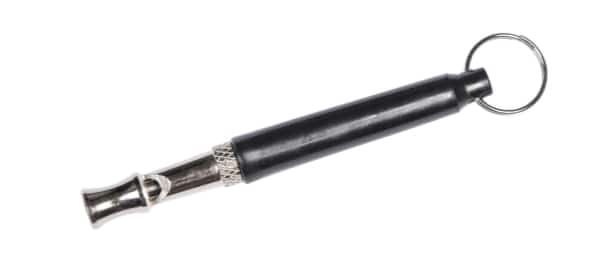Barking is prevented by a dog whistle when:
- It is correctly pitched for the dog
- The same length and type of whistle is used each time
- The owner perseveres in training the dog
- It is coupled with positive reinforcement training methods
- The dog has been consistently trained to respond
Every dog barks occasionally. Often, they bark to alert you to something, but if they bark at the slightest provocation, you’ll probably want to stop that behavior. It’s annoying for you, and it could be annoying for your neighbors too.
One potential tool to have in your armory for dog training is a dog whistle. Many owners have used a dog whistle to put a stop to barking and succeeded. Could you do the same?
I’ve dug into this topic and discovered some fascinating information online that is sure to help you get the results you want. If you’re looking for guidance on how best to use a whistle to stop incessant barking, you’re in the right place to learn everything you need to know.
Different Dogs Respond to Different Whistle Pitches

One thing I soon noticed when I started researching this topic was that some whistles got bad reviews. Reading through those reviews was eye-opening.
All the negative reviews ran along the same lines:
- Their dog didn’t respond
- The whistle didn’t work
The positive reviews highlighted a few other elements too:
- Whistle adjustment helps to get the best results
- Repeated behavior helped achieve positive results
- Positive reinforcement was used along with the whistle
See the passive/active change between the two lists? This information shows that doing these things along with the whistle, can help you get the most out of it when you want any excess barking to be nipped in the bud.
Most good dog whistles are adjustable. This means you can change the frequency the dog hears. I even spotted one online that could be downloaded onto an Android smartphone. It was a free app and had adjustable frequency and volume controls.
Remember this when looking for the best whistle to use. If your pooch doesn’t respond to the first attempt, keep trying and adjusting until you succeed.
How to Get the Right Pitch for Each Dog

Experimentation is key here. Getting the right pitch is the first and most important thing to get right.
Remember that you may not hear the frequency the whistle operates on. A dog can hear higher-pitched frequencies than you or I. That’s why testing is important.
One fascinating source I read mentioned that the whistle should be tested while your dog is napping. Have it ready (some hang on a lanyard around the neck, or you can tuck into your pocket) ahead of time.
Use the whistle and see if your dog reacts to it. If the whistle is pitched correctly, your dog will react even when sleeping. If you don’t get a reaction, adjust the whistle, and try again.
You don’t need to wait until your pooch is napping though – this is just one option. You can get their attention when they’re awake too – you’ll know if they can hear the frequency you’re using.
Most whistles have an adjustable section that can that be covered to make sure you don’t accidentally knock or move it once you’ve got it at the right pitch.
You Do Not Need to Be Next to Your Dog to Use the Whistle

Once you’ve hit the right frequency, you’ll be able to blow the whistle even at a distance. Remember, sheep herders use these whistles to control their dog even when it is on the other side of a large field.
This means you can stop your dog from barking by tooting on the whistle even when your dog is in another room in your home, or even in the yard. They’ll still hear it.
This is where a dog whistle can be far more powerful than using another method of training to stop unwanted barking. Imagine being upstairs when your dog starts barking in the yard and doesn’t stop. You don’t want to be racing downstairs to try and stop it. Your whistle means you shouldn’t need to.
Use the Same Pitch and Length Every Time
When you begin to train your dog using the whistle, make sure you decide how to blow it and for how long. A quick firm blow should suffice. Think how quickly you can say the word ‘Stop!’ Toot the whistle for about the same time. Firmly.
Whatever you do, remember it. Your dog is going to learn to associate that sound with the need to stop barking.
If you read stories about sheep herders using a whistle to help a sheepdog round up the sheep, or even a dog trainer using one of these whistles, you’ll know they use different signals for different commands.
If you try this method and experience problems with it, think about whether you are being consistent with your whistle every time. This is necessary, otherwise your dog is going to get confused.
Imagine you use a short sharp toot to get the barking to cease. Now, imagine the next time your dog does it, you use a longer toot. Don’t be too surprised if your dog doesn’t stop barking. Or, your pooch could stop but then start again, as the signal isn’t the same one the dog is used to.
Keep things simple – stick to the same signal. If anyone else in your household is going to use the whistle, make sure they know and can replicate that same signal too.
Practice Positive Reinforcement Training Methods
Many examples of training a dog to respond to a whistle involve positive outcomes for the dog.
One method explained how the whistle should be blown whenever the dog barks. If – and only if – your dog stops barking, you give them praise. Plenty of fusses and a treat are good for this.
Now, in some cases and with some dogs, the barking doesn’t stop with the first blow of the whistle. If you experience this, blow it again. Repeat the process until your dog does stop. At this point, bring in the reward.
Most dogs respond to tons of fusses and praise along with the treat, too. My pooch Freya certainly does, so don’t be afraid to go overboard with this part of the training. She loves it!
You may wonder how this works given that I mentioned a whistle can be used some distance away from your pooch – even out of their eyeline. Truth is, if you have trained your dog using positive reinforcement methods, your pooch will know and understand that if they stop barking, there’s a reward in it for them.
That means they’ll likely seek you out or wait for you to appear. Returning to you after they stop barking is a good thing, as your dog will want to be rewarded. That could be with praise, of course – it doesn’t need to be with a treat.
A Whistle Can Potentially Be Used to Stop a Neighbor’s Dog Barking

I was keen to find out whether this was possible, so I researched this in-depth online. Reading reviews of various dog whistles produced different outcomes. Some people said it worked with nearby dogs, while others say it didn’t.
However, failures could be down to two things:
- The wrong frequency for that dog – it’s harder to see if your neighbor’s dog responds to a frequency if you can’t see the pooch
- A lack of positive reinforcement – you can’t train a dog the other side of your fence as you would your own pooch
Additionally, I’ve found lots of stories confirming that some dogs respond better than others. There is no guarantee a whistle will prevent any dog from excessively barking. It seems to work with most given the right training and effort from the owner.
And as we have seen, that is harder to achieve when you are dealing with a dog that isn’t your own.
Bottom line? If your neighbor’s dog barks a lot and irritates you and others living nearby, it’s probably best to chat with the neighbor face to face first. Try not to be angry – just mention the issue and see if you can come to an agreement on how to tackle it.
Consistency is Key
Training doesn’t happen overnight in any situation. Our dog Freya has been in our home since she was nine weeks old. It took months until she was 100% potty trained to go outside.
I remember thinking it would never happen. I despaired. I worried she would be the only Bichon Frise in our neighborhood who wasn’t properly potty trained.
Bichons are known to have a stubborn streak, but I still felt like a failure.
We got there in the end, of course. Consistency and perseverance were the keys to success. The same applies with whistle training if your dog barks a lot, and you want to stop it from happening.
Get a couple of whistles and make sure you go through each day wearing one around your neck or tucking it into a pocket whenever you are with your dog. Your pooch might be a good learner and quit barking quickly. On the other hand, it could take a while.
But don’t quit. Whistle training to stop excessive barking in dogs does work if you stick at it.

Sources:
https://www.amazon.com/Ortz-Dog-Whistle-Stop-Barking/dp/B0159CHOL6
https://www.amazon.com/Whistle-Stop-Barking-Silent-Control/dp/B07Y2Z7HDF
https://gooddogsco.com/best-dog-whistle/
https://www.psychologytoday.com/us/blog/canine-corner/201511/are-silent-dog-whistles-useful
https://lifehacker.com/how-to-get-your-neighbor-s-dog-to-stop-barking-incessan-1792297205
https://wagwalking.com/training/stop-barking-with-a-whistle
https://play.google.com/store/apps/details?id=com.dma.anti.dog.bark.sounds.whistle&hl=en_US

